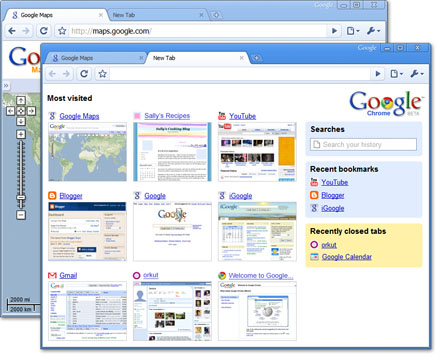Teachers are joining students in learning and applying new skills at Woodland Park High School in Colorado Springs. Sharing their experiences in educational vodcasting makes for a good back-to-school news story, but more than that, the approach of Jonathan Bergmann and Aaron Sams might lead teachers to think about why they teach the way they do, and to re-assess the value of in-class lectures.
Whether or not students would see the viewing of lectures as 'work' there are a number of reasons that I love this strategy:
Kids demonstrate their knowledge and understanding during class;
Students can be observed applying appropriate strategies/skills;
Teachers have time to coach all learners;
Students have ready access to the teacher support when 'working';
This strategy allows time for oral exams; consultation; performance assessment;
Collaborative projects can more readily be undertaken with the time available;
Teachers get to meet regularly with learners and to act as mentors and co-learners;
Lessons can be reviewed as necessary by students;
Great lectures can be saved, recalled, re-used...
What am I missing?
Tuesday, September 30, 2008
Sunday, September 28, 2008
Par for the Course
This weekend I took a break from teaching and learning to attend a wedding celebration. The highlight of the weekend, came when I had the opportunity to play the Stone Ridge Golf Club at Elliot Lake, north of Lake Huron. Although the colours in southern Ontario have yet to peak, if this autumn preview in northern Ontario is any indication, it's going to be a spectacular October!
 Mist on the lake set the tone for a magical morning.
Mist on the lake set the tone for a magical morning.
 Of course, there had to be a real 'stone ridge' on this course.
Of course, there had to be a real 'stone ridge' on this course.
 Trees, rocks and rough provide rich contrast to fairways and greens.
Trees, rocks and rough provide rich contrast to fairways and greens.
 The driver led the way to an even par back nine.
The driver led the way to an even par back nine.
 The view from the cart was memorable, especially from the fairways.
The view from the cart was memorable, especially from the fairways.
 The breathtaking par three 16th was home to a short birdie putt.
The breathtaking par three 16th was home to a short birdie putt.
 The 18th requires a carry of 250 yards in order to go at the green.
The 18th requires a carry of 250 yards in order to go at the green.

Even if you aren't golfing, the site is worthy of a postcard.
 Mist on the lake set the tone for a magical morning.
Mist on the lake set the tone for a magical morning. Of course, there had to be a real 'stone ridge' on this course.
Of course, there had to be a real 'stone ridge' on this course. Trees, rocks and rough provide rich contrast to fairways and greens.
Trees, rocks and rough provide rich contrast to fairways and greens. The driver led the way to an even par back nine.
The driver led the way to an even par back nine. The view from the cart was memorable, especially from the fairways.
The view from the cart was memorable, especially from the fairways. The breathtaking par three 16th was home to a short birdie putt.
The breathtaking par three 16th was home to a short birdie putt. The 18th requires a carry of 250 yards in order to go at the green.
The 18th requires a carry of 250 yards in order to go at the green.
Even if you aren't golfing, the site is worthy of a postcard.
Wednesday, September 24, 2008
Common Craft Teaches Web Search
Cool!
Lee and Sachi LeFever have just posted a new Common Craft Video:
Web Search Strategies in Plain English from leelefever on Vimeo.
For those looking for more 'how-to search' tips, and for a way that students can apply what they learn, feel free to visit the Google Incorporated, a rich performance task I wrote a few years ago to teach teachers and students how to Google for Gold.
Lee and Sachi LeFever have just posted a new Common Craft Video:
Web Search Strategies in Plain English from leelefever on Vimeo.
For those looking for more 'how-to search' tips, and for a way that students can apply what they learn, feel free to visit the Google Incorporated, a rich performance task I wrote a few years ago to teach teachers and students how to Google for Gold.
Tuesday, September 23, 2008
CCK08 Concept Maps

The above map is my attempt to show how information travels in connections beginning with the wiring in the brain; moving to wiring in machines and the Internet; and returning to the brains of course participants.
The more I try to create a concept map around my current understanding of Connectivism, the more I am coming to realize:
1] Thinking in words graphically represented, forces you to see connections you would not otherwise see;
2] Three dimensional models of connectivism would be even richer... but working in 2 dimensions is challenging enough;
3] The more I try to show relationships among ideas, the more I know I don't know so much! This is a challenging task;
4] That concept maps can show relationships more succinctly than words, but the cost in time can be significantly greater on the part of the creator;
5] Ideas with images provide greater insight than do words and arrows among boxes and hexagons;
6] I need to re-prioritize the reading of Dan Roam's Back of the Napkin.
For fun, here is an earlier concept map that I created with Smart Ideas to arrange broad concepts, tools and activities we've been using to explore connectivism. The end result is not nearly as chaotic as I'd originally envisioned.

Labels:
back of the napkin,
CCK08,
concept map,
connectivism,
creative thinking,
dan roam,
maps
Friday, September 19, 2008
Pouring Resources OUT of Schools
 I've always believe that feedback for learners should be kept confidential, and that the information provided to the learner should consist of much more than numbers. In seeming contradiction, the Education Quality and Accountability office (EQAO), has just released board, school, and classroom results for last year's mathematics and language testing.
I've always believe that feedback for learners should be kept confidential, and that the information provided to the learner should consist of much more than numbers. In seeming contradiction, the Education Quality and Accountability office (EQAO), has just released board, school, and classroom results for last year's mathematics and language testing.Newspapers are keen to publish the results of community schools with comparisons to the provincial mean, but nothing other than the numbers seems to result from these assessments. While the scores may do plenty to indicate disparities among a region's learning communities, I'd feel better about the assessments if constructive recommendations were provided with the numbers.
Absent recommendations in the news, here is my advice:
The best way to ameliorate the problems is not to pour money into schools, but to pour resources out of schools.
We know that the strongest indicators of success on standardized tests, are family income, and the availability of learning resources (books, CDs, DVDs...) within the home. Why have so few come to the realization that schools can become learning centres for entire communities.
If we believe that the school resource centre is there to ensure learning materials find their way into homes throughout the district, then maybe it's time we open the doors to the entire community rather than limiting lending to the student body. Parents and caregivers would be able to drop into any school in order to borrow educational games, books or other learning materials. Families without access to computers, might be able to teach themselves about the world wide web. With a simple school library card, these users might regularly refresh the learning materials in their homes.
 To take it a step further: What if these school libraries were wired into the public library system? Community members might then order materials from a broader, richer selection, that could be shared from school to public library and back again.
To take it a step further: What if these school libraries were wired into the public library system? Community members might then order materials from a broader, richer selection, that could be shared from school to public library and back again.I'm not so sure that the annual test scores are worthy of front page news, and I'm even less sure that school boards should be so reactionary as to pour staff and resources into schools that score below par. Instead, let's use the information to develop a targeted strategy that enriches the home learning environment. More than our students would benefit!
Podcast Version: Teacher 2.0 Episode #116
Photo Credits: Kristin Pishdadi; Dory Kornfeld
Wednesday, September 17, 2008
CCK08: Follow the Yellow Brick Road

Boltzmann, Witchenstien, Polanyi... Oh My!
During my noon hour today, I had the opportunity to join 40 CCK08 participants in what turned out to be an audio tutorial on "Rethinking epistemology: Connective knowledge". Although complex language was used to explain competing views , I found a path to follow - call it a yellow brick road of sorts.
While what is 'true' continues to move around in my mind, one pathway is being reinforced: the idea that learning has to be connected to an individual's experience, in order to gain traction.
One might think that the disagreements in our individual responses to the theory of connectivism might be due to the fact we've read different things, or that we've read things differently; but I now suspect that our diverse understandings are directly the result of our varied 'prior experiences'. After all, we have to 'connect' these new ideas, to existing understandings.
Stephen Downes brought this home for me when he broke down what at first seemed to be a straightforward question: "What is the capital of France?".
The number of connections necessary to make meaning of this question, gave me great pause. In order to respond with understanding, concepts of physical geography, cartography, politics, civics and more, would have to be considered. The thought struck me that the individuals in any classroom, are experiencing unique learning experiences, no matter the strategies being employed. Indeed, it may well be impossible for everyone in a room to make identical connections
The road became an even brighter shade of yellow with Dave Cormier's clarification of Rhizomatic Education. Hearing that "Learners need for the curriculum to arise from the group, in order to develop literacies and to make their own knowledge, and adapt to the world as it will be." My neurons made the 'connection' to the Reggio Emilia educational approach (which I first read about in Howard Gardner's "Frames of Mind"). It was the first time since the course began, that I was able to connect a concept from this course, to a concrete classroom application!
Just as the children in Reggio Emilia classes must have opportunities to explore relationships with fellow students and with a choice of materials, so too must participants in this course be provided with the freedom to explore areas of personal interest, and to make connections with fellow course participants.
Whether the 'connections' we're making are leading us to Oz or to Paris, at least we're having a say in which paths to take, and with which colleagues to link arms and ideas.
Photo Credit: Valerie
Tuesday, September 16, 2008
How to Blog
Condescending? Arrogant? Quick-witted? Outspoken? Honest!
"Say it in a Voice you Believe in!"
One thing Merlin Mann is great at, is "Getting Things Done". If you haven't seen Merlin Mann speak, it may be worth getting past the emcee (scroll ahead 5 minutes...) to check out his recorded talk from IzeaFest.
"Say it in a Voice you Believe in!"
One thing Merlin Mann is great at, is "Getting Things Done". If you haven't seen Merlin Mann speak, it may be worth getting past the emcee (scroll ahead 5 minutes...) to check out his recorded talk from IzeaFest.
Monday, September 15, 2008
All Dog Ball Club
 With the Detroit Tigers safely out of the pennant race, it's time to send baseball to the dogs before I adopt a new playoff favourite.
With the Detroit Tigers safely out of the pennant race, it's time to send baseball to the dogs before I adopt a new playoff favourite. Here is my 'all dog' fantasy starting line-up:
Centre Field: Astro
Second Base: Snoopy
Catcher: Wile E. Coyote
First Base: Clifford
Third Base: Scooby Doo
Designated Hitter: Goofy
Left Field: Marmaduke
Short Stop: Hong Kong Phooey
Right Field: Huckleberry Hound
Starting Pitcher: Krypto
Relief Pitcher: Underdog
Manager: Mr. Peabody
Pitching Coach: Pongo
First Base Coach:Deputy Dawg
Third Base Coach: Augie Doggie
Am I missing any great dogs who can substitute in case of injury? Would you re-work the batting order? Are any of these dogs better suited to other positions?
Photo Credit: Elisabeth
Saturday, September 13, 2008
I Hear Voices
The world is learning to use its collective voice like never before in communicating its thoughts, desires and opinions. This realization has become more real to me since joining my brother Todd for a conversation titled "Power to the People".
 Recent news stories demonstrate how the public is bringing its influence in a more rapid fashion than has ever before been possible. After a calls to action in editorials and blogs like McLuhan's Ghost, the Green Party of Canada was able to overcome a threatened boycott, and will now take part in Canada's pre-election leaders debate.
Recent news stories demonstrate how the public is bringing its influence in a more rapid fashion than has ever before been possible. After a calls to action in editorials and blogs like McLuhan's Ghost, the Green Party of Canada was able to overcome a threatened boycott, and will now take part in Canada's pre-election leaders debate.
At the same time, south of the border,
American voices are sharing their opinions of the US presidential and vice-presidential candidates thanks to the mashup work of MIBAZAAR.
I heard about my favourite voice-sharing story quite appropriately, via a radio show. The Telemegaphone project was highlighted on one of my favourite CBC podcasts, your guide to the next big thing: Spark. The Telemegaphone is a large speaker mounted to broadcast phone calls across the hills and fjords of Dale, a town in western Norway. You dial the number, and your voice is heard by the citizenry.

I'd love to see this idea reversed so that instead of this small town receiving ideas, music, and greetings from around the world; listeners around the world, could tune in to listen to commentary from small town individuals through an 'always on' Internet broadcast. This type of John Q. Public broadcasting is already happening with YouTube and Podcasting, but even simpler tools like www.earfl.com, VoiceThread and Seesmic are already making it possible for groups or random individuals to share their thoughts with their real voices.
As more and more of these applications leverage cell phone technology rather than desktop or notebook computer technology, it's easy to imagine a time when we open our cell phones to listen to geo-tagged telephone messages placed by people all around the world. Projects like Murmur and tools like GeoGraffiti are already allowing users to tap into an unseen network in order to post and/or download audio tags, historic commentary, and personal storytelling.
Who knows... Maybe one day, it will be common for educators to harvest student voices?
Photo Credit: Mirko Garufi
 Recent news stories demonstrate how the public is bringing its influence in a more rapid fashion than has ever before been possible. After a calls to action in editorials and blogs like McLuhan's Ghost, the Green Party of Canada was able to overcome a threatened boycott, and will now take part in Canada's pre-election leaders debate.
Recent news stories demonstrate how the public is bringing its influence in a more rapid fashion than has ever before been possible. After a calls to action in editorials and blogs like McLuhan's Ghost, the Green Party of Canada was able to overcome a threatened boycott, and will now take part in Canada's pre-election leaders debate. At the same time, south of the border,
American voices are sharing their opinions of the US presidential and vice-presidential candidates thanks to the mashup work of MIBAZAAR.
I heard about my favourite voice-sharing story quite appropriately, via a radio show. The Telemegaphone project was highlighted on one of my favourite CBC podcasts, your guide to the next big thing: Spark. The Telemegaphone is a large speaker mounted to broadcast phone calls across the hills and fjords of Dale, a town in western Norway. You dial the number, and your voice is heard by the citizenry.

I'd love to see this idea reversed so that instead of this small town receiving ideas, music, and greetings from around the world; listeners around the world, could tune in to listen to commentary from small town individuals through an 'always on' Internet broadcast. This type of John Q. Public broadcasting is already happening with YouTube and Podcasting, but even simpler tools like www.earfl.com, VoiceThread and Seesmic are already making it possible for groups or random individuals to share their thoughts with their real voices.
As more and more of these applications leverage cell phone technology rather than desktop or notebook computer technology, it's easy to imagine a time when we open our cell phones to listen to geo-tagged telephone messages placed by people all around the world. Projects like Murmur and tools like GeoGraffiti are already allowing users to tap into an unseen network in order to post and/or download audio tags, historic commentary, and personal storytelling.
Who knows... Maybe one day, it will be common for educators to harvest student voices?
Photo Credit: Mirko Garufi
Labels:
audio,
cell phones,
murmur,
podcast,
spark,
telemegaphone,
voices,
voicethread
Friday, September 12, 2008
Getting Beyond Parallel Processing
The dinner bell rang; Everyone came; Most sat silently through the appetizer...

The richness of the CCK08 course is not in the content, but in the interactions of the participants. Unfortunately, the conversation is not so likely to come to you, if you don't take the leap to attach your ideas to those of the others in the course.
Instead of working in parallel with the others in this course who are processing the rich information in the presentations and links shared by Stephen and George, I think more can be accomplished if we reflect, compare, contrast and build on the ideas of others.
As the main course of this rich meal comes to the table, I'll be making the effort to add my ideas to those of others in this course, maybe you'll do the same? Connectivism isn't found in the facts we process, but in the connections we make!
FYI, Today's Teacher 2.0 Podcast touches on this idea of parallel processing in the classroom.
Photo Credit: Groovnik

The richness of the CCK08 course is not in the content, but in the interactions of the participants. Unfortunately, the conversation is not so likely to come to you, if you don't take the leap to attach your ideas to those of the others in the course.
Instead of working in parallel with the others in this course who are processing the rich information in the presentations and links shared by Stephen and George, I think more can be accomplished if we reflect, compare, contrast and build on the ideas of others.
As the main course of this rich meal comes to the table, I'll be making the effort to add my ideas to those of others in this course, maybe you'll do the same? Connectivism isn't found in the facts we process, but in the connections we make!
FYI, Today's Teacher 2.0 Podcast touches on this idea of parallel processing in the classroom.
Photo Credit: Groovnik
Labels:
CCK08,
connectivism,
networking,
parallel processing
Wednesday, September 10, 2008
Networks Inside and Out

In our introduction to Connectivism, I smiled at finding direct parallels between the way information percolates through a human network; and the way it is thought to leap microscopic chasms in the human brain.
Networks on the Inside
I love John Medina's descriptive metaphor for physical learning in the brain:
Beginning with the realization that most cells look like fried eggs, Medina suggests how to turn it into a nerve cell, consisting of the cell body and dendrites: "Take that fried egg and smash it with your foot, splattering it across the floor. The resulting mess might look like a many-pointed star. Now take one tip of that star, and stretch it out. Way out. Using your thumb, now squish the farthest region of the point you just stretched. This creates a smaller version of that multipronged shape. Two smashed stars separated by a long, thin line. There's your typical nerve."
The connections between neurons in an "underwater forest" are as if the roots of trees have been jammed together... and "usually, thousands of neurons are jammed up against one another..."
 After an "Fantastic Voyage" description of cell communication, Medina goes on to explain what learning might resemble: "Like snakes swaying to the rhythm of some chemical flute, some of these branches appear to be moving. Occasionally, the end of one neuron swells up, greatly increasing in diameter. The terminal ends of other neurons split down the middle like a forked tongue, creating two connections where there was only one. Electricity crackles through these moving neurons at a blinding 250 miles per hour, some quite near us, with clouds o f neurotransmitters filling the spaces between the trunks as the electric current passes by."
After an "Fantastic Voyage" description of cell communication, Medina goes on to explain what learning might resemble: "Like snakes swaying to the rhythm of some chemical flute, some of these branches appear to be moving. Occasionally, the end of one neuron swells up, greatly increasing in diameter. The terminal ends of other neurons split down the middle like a forked tongue, creating two connections where there was only one. Electricity crackles through these moving neurons at a blinding 250 miles per hour, some quite near us, with clouds o f neurotransmitters filling the spaces between the trunks as the electric current passes by."Networks on the Outside
With each of us playing the part of a neuron in a much larger though less interconnected network, I'm sure many see parallels with the idea of being squashed, and stretched thin; but the reality is that we too are communicating in networks without coming in physical contact with one another. Information traverses the distances between human nodes by eerily similar electronic impulses. The branches of our networks are likely as intertwined as are our neurons, with only a few degrees of separation dividing any two networked educators.
Learning networks continually experience expansion, pruning, adaptation and rewiring as less useful nodes are abandoned for the fresh ideas of new individuals who energize online discussions. The idea that nodes of influence can become energized and multiply via RSS and hyperlinking, acts as a direct parallel to actions of energized neurons who split and reach out in new directions in Medina's explanation of learning. The new connections that result, are evidence of learning, not only on the part of individual, but on the part of the network itself.
Networks on My Mind
With my current professional role in e-learning, I've experienced the reality that the human connections are in fact more valuable than any idea or resource that might be shared within a group. As connectivist ideas continue to invade my interior network, I'm finding that same bundle of neurons to be the best aid in comprehending connectivist frameworks.
References:
Medina, J. J. (2008). Brain Rules: 12 Principles for Surviving and Thriving at Work, Home, and School. Seattle, Washington: Pear Press.
Photo Credits: GustavoG; Lorelei Ranveig
Labels:
brain rules,
CCK08,
fantastic voyage,
john median
Monday, September 8, 2008
My Secret Subscription
If you don't subscribe to Post Secret yet, this video may lead you to a compelling habit of awaiting postcards from people you don't even know...
Sunday, September 7, 2008
Will Lurkers share their Cognitive Surplus?
With the impending launch of CCK08, I've been thinking about the 'real' participants in this massive open online course. The number of folks who have are receiving the introductory 'Daily' from Stephen Downes and George Siemens is now touted at 'just under 1900', but how many will actually participate?
In Stephen's introductory email, it is clear, that the facilitators hope to provide differentiated learning experiences: "We expect, and want, each student to have a different perspective, to have viewed different resources. That's part of the theory of Connectivism, the idea that people have unique experiences."

En masse, those with the greatest potential to impact in the course, will be lurkers. Ken Allan, distance educator from New Zealand in a web article titled "Working with Online Communities led me to this conclusion:
"One behaviour in online groups that has been extensively studied is that of the non-participating members, termed the ‘lurkers’ - Etienne Wenger[2] calls them Legitimate Peripheral Participants. Lurkers are widely known to be among the majority of defined members and they have been found to make up over 90% of most online groups. They are perhaps the most important members in view of their potential to contribute to online groups."
To consider the potential impact of lurkers, familiarize yourself with Metcalfe's Law. My interpretation is that ""The value of a network increases exponentially with the increase in the number of 'active' nodes.
As Clay Shirky might suggest: "The value in media is no longer in sources but in flows; when we collaborate in sharing our cognitive surplus, it creates value that doesn't exist when we operate in isolation.""
While interested lurkers are more than welcome to engage with the content of CCK08, I'd like to invite the 1900 who expressed an interest, to engage with the participants of the course... If you need to step in lightly, maybe you'll consider adding a comment below?
Audio: If you'd like to learn more about CCK08, listen in on a conversation I had with my brother, which he published as the 'What is Connectivism Podcast'
Image: The map image is a screen grab from the collaboratively developed Google Map of CCK08 Participants.
Video: Clay Shirkey's "Cognitive Surplus" talk was recorded at Web 2.0.
In Stephen's introductory email, it is clear, that the facilitators hope to provide differentiated learning experiences: "We expect, and want, each student to have a different perspective, to have viewed different resources. That's part of the theory of Connectivism, the idea that people have unique experiences."

En masse, those with the greatest potential to impact in the course, will be lurkers. Ken Allan, distance educator from New Zealand in a web article titled "Working with Online Communities led me to this conclusion:
"One behaviour in online groups that has been extensively studied is that of the non-participating members, termed the ‘lurkers’ - Etienne Wenger[2] calls them Legitimate Peripheral Participants. Lurkers are widely known to be among the majority of defined members and they have been found to make up over 90% of most online groups. They are perhaps the most important members in view of their potential to contribute to online groups."
To consider the potential impact of lurkers, familiarize yourself with Metcalfe's Law. My interpretation is that ""The value of a network increases exponentially with the increase in the number of 'active' nodes.
As Clay Shirky might suggest: "The value in media is no longer in sources but in flows; when we collaborate in sharing our cognitive surplus, it creates value that doesn't exist when we operate in isolation.""
While interested lurkers are more than welcome to engage with the content of CCK08, I'd like to invite the 1900 who expressed an interest, to engage with the participants of the course... If you need to step in lightly, maybe you'll consider adding a comment below?
Audio: If you'd like to learn more about CCK08, listen in on a conversation I had with my brother, which he published as the 'What is Connectivism Podcast'
Image: The map image is a screen grab from the collaboratively developed Google Map of CCK08 Participants.
Video: Clay Shirkey's "Cognitive Surplus" talk was recorded at Web 2.0.
Labels:
CCK08,
clay shirky,
cognitive,
george siemens,
ken allan,
stephen downes,
surplus
Thursday, September 4, 2008
13 Great Map Web Apps

1] FlickrVision: Great workshop tone-setter (mind you the risk will always be there for inappropriate photos...)
2] ClustrMaps: Easy to embed, and great for tracking site visitors. Scroll to the bottom of this page for a sample.
3] Google Maps: Easy to create; You can add text, hyperlinks, photos. An evolving example: CCK08 Participant Map.
4] Visual Complexity: Maps of many different types to show 'information'. See more than the screen captures by visiting the links from each page... simply amazing visualizations!
5] FlashEarth: Not quite Google Earth, but a full screen interactive model of the earth. Tour NASA map; open layers; Microsoft Virtual Earth...
6] TwittEarth: Twitter fans might like to see where international tweets are coming from. This is another great tone-setter.
7] Map of the World 2.0: A mosaic of logos recreates the planet.
8] Traveler IQ Challenge: A fast-paced game that rewards both speed and accuracy in plotting major cities on a world map. If you prefer to learn countries, a slower paced 'blackline master' game is available at GameDesign
9] MapMe.com: Create and share maps that include photos, audio and video.
10] GeoGraffiti: One for iPhone users! Add audio tags to locations you visit. Other users can use the GPS capabilities of their phones to listen to historic re-enactments; public reminiscing, or live anecdotes.
11] Music Map: Which bands are closely related to others? It is surprisingly relevant for finding artists similar to your favourites.
12] Intellicast: My favourite North American weather map resource. Animated radar is super-effective in helping me anticipate precipitation.
13] Global Political Map: This full screen, zoomable PDF is the best I've found. The map is accurate as of 2007. The 2004 version is also available.
What other great mapping tools would you add to this list?
Photo Credit: NASA
Wednesday, September 3, 2008
CCK08 is Truly Global
The massively open online course "Connectivism and Connected Knowledge" is about to launch and people from around the world have already introduced themselves on the course site. Maybe I shouldn't be so surprised to see such interest from educators all around the planet, but I can't help but feel part of a larger community in watching as the introductions continue.
In order to give folks some idea of how global participation is expected to be, I created a quick Google Map for CCK08, where participants can drop a pin and add their names. The technology allows for the posting of HTML content including photos, but let's take it one step at a time...
The instructions for adding yourself to the map are quite simple and appear below:
In order to give folks some idea of how global participation is expected to be, I created a quick Google Map for CCK08, where participants can drop a pin and add their names. The technology allows for the posting of HTML content including photos, but let's take it one step at a time...
The instructions for adding yourself to the map are quite simple and appear below:
Tuesday, September 2, 2008
Chrome Comes to Life
It's Here! Google Chrome and it's companion open source code page, Chromium, are now available in beta form for PC users. Highlights include: ready access to the sites you visit most often; an intuitive search/address bar called 'omnibox'; and a minimalist package worthy of Google's heritage.
Here are my first impressions, including a quick comparison to Firefox, Safari, and Flock (6 minutes).
I'm guessing that Chrome will soon be a key component of Android and the Google Phone, and while it's not earth-shaking enough to get me to run Microsoft Windows, I'll be downloading the Mac version when it's ready for prime time.
Here are my first impressions, including a quick comparison to Firefox, Safari, and Flock (6 minutes).
I'm guessing that Chrome will soon be a key component of Android and the Google Phone, and while it's not earth-shaking enough to get me to run Microsoft Windows, I'll be downloading the Mac version when it's ready for prime time.
Monday, September 1, 2008
Google Gets into the Browser Game
It makes perfect sense. For years, Google has been the search tool of popular choice, so why shouldn't they be in the browser business? The news on the Official Google blog says they will be joining the game with "A Fresh Take on the Browser".

The launch of Google Chrome promises to create an era of fresh thinking in response to the realities of Web 2.0. Even with tabbed browsing, most browsers run on engines created to take advantage of one web resource at a time. Google intends it's browser to be capable of multi-tasking, while handling the full range of evolving web applications.
 Google's own comic book explanation clearly outlines the goals of the project, but I prefer the crisper version posted by Blogoscoped.com.
Google's own comic book explanation clearly outlines the goals of the project, but I prefer the crisper version posted by Blogoscoped.com.
The beta release of Google Chrome is intended exclusively for MS Windows, but versions for Mac and Linux are promised. My fingers are crossed in the hope that Google Chrome will get us on track to use the browser as a powerful app, rather than a simple window to the web.
Late addition: Live Blog of the press conference/demo/launch says the code for this browser will be very open. If you're into that sort of thing, visit Chromium.
Later addition: It's available now! http://www.google.com/chrome
Image Credit: The comic book is shared by Google via Creative Commons attribution, non-commercial, no derivative works 2.0 creative commons license

The launch of Google Chrome promises to create an era of fresh thinking in response to the realities of Web 2.0. Even with tabbed browsing, most browsers run on engines created to take advantage of one web resource at a time. Google intends it's browser to be capable of multi-tasking, while handling the full range of evolving web applications.
 Google's own comic book explanation clearly outlines the goals of the project, but I prefer the crisper version posted by Blogoscoped.com.
Google's own comic book explanation clearly outlines the goals of the project, but I prefer the crisper version posted by Blogoscoped.com. The beta release of Google Chrome is intended exclusively for MS Windows, but versions for Mac and Linux are promised. My fingers are crossed in the hope that Google Chrome will get us on track to use the browser as a powerful app, rather than a simple window to the web.
Late addition: Live Blog of the press conference/demo/launch says the code for this browser will be very open. If you're into that sort of thing, visit Chromium.
Later addition: It's available now! http://www.google.com/chrome
Image Credit: The comic book is shared by Google via Creative Commons attribution, non-commercial, no derivative works 2.0 creative commons license
Subscribe to:
Comments (Atom)



